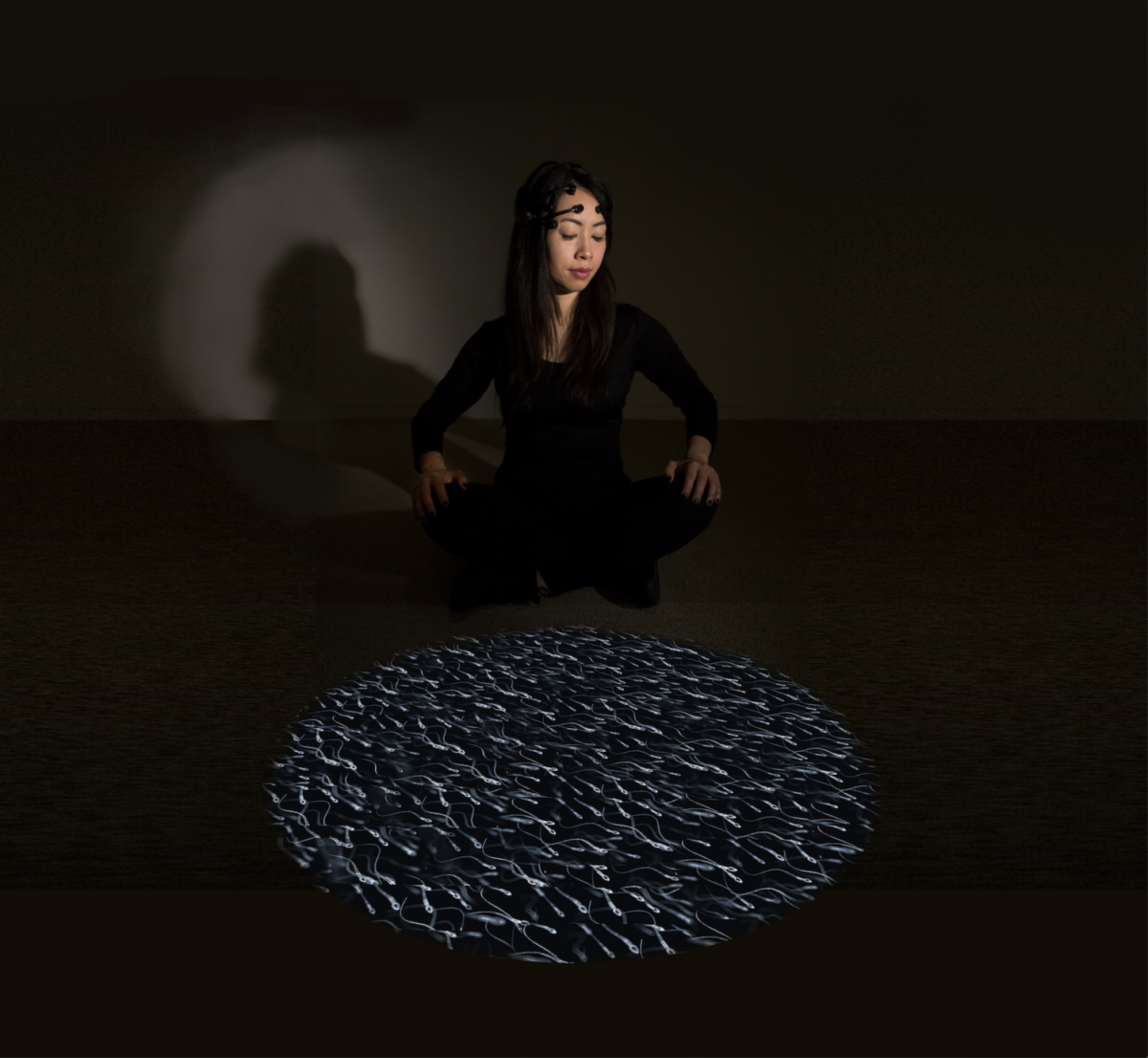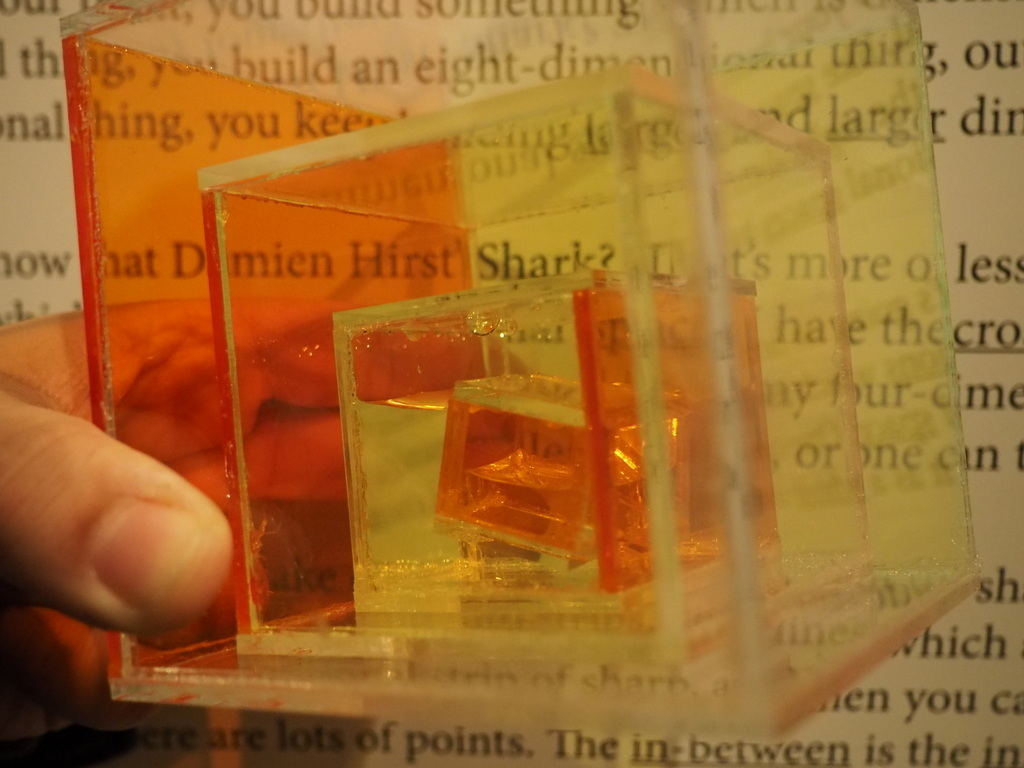The Schnitzer Prize was established in 1996 through an endowment from Harold and Arlene Schnitzer of Portland, Oregon. Harold Schnitzer, a real estate investor, graduated from MIT in 1944 with a degree in metallurgy. The prizes—a first prize of $5000, second prize of $3000, third prize of $2000 and honorable mentions of $1000—are awarded to undergraduate and graduate students for excellence in a body of artistic work. This year’s recipients represent the diverse academic backgrounds of contemporary artists, as well as the distinctive creative culture of MIT, where science, technology, and art inform each other.
An exhibition of selected works by the Schnitzer Prize winners—Ani Liu, Angel Chen, Jessica Rinland, Anne Graziano, and Edwina Portocarrero—was on view in the Wiesner Student Art Gallery in June 2017.
Ani Liu
Ani Liu, the first-prize winner, is an interdisciplinary artist and graduate student in the Media Lab in the Design Fiction group. In her research-based art, she explores the cultural implications of emerging technologies. Her work includes architectural installations, wearable prosthetics, augmented reality, and synthetic biology.
Her evocative biological design objects include: “Kisses from the Future,” a petri dish of micro-organisms cultured from a kiss; “Forget Me Not,” a plant that is engineered to emit a person’s odor, reversing the perfumer’s art of applying floral fragrances to people; and “The Botany of Desire: Experiments in Interspecies Interfaces,” which tests the limits of interspecies empathy. Ani’s expansive portfolio also includes digital and analog works that investigate everything from networked reality to falling in love.
For her thesis work, she controls the movement of sperm with her mind. She describes the work as a “biopolitical feminist art piece” and says it allows her both “to push the limits of what I was able to accomplish technologically, in terms of the engineering” and “to question who gets control over bodily rights, and what kind of metaphorical acts can empower and make us question the status quo.”
Angel Chen
In her work, the second-prize winner Angel Chen (SMACT ’17) uses scientific materials and constructs to question what science and technology produce beyond practical empirical knowledge. In “This is Walnut,” she worked with technicians in various labs at MIT to produce images of a walnut using such imaging machines as MRIs and scanning electron microscopes (SEM). The resulting three-part installation, she says, “explores the tension between experiences of the real versus the virtual.”
For “Project Lin Daiyu,” she explores what it would be like to create a material based on the female protagonist Lin Daiyu found in the Chinese classic, Dream of the Red Mansion (written in the mid-18th century and first translated into English in 1812). Bringing together researchers in various fields (visual art, literary criticism, bioengineering, astrophysics), the work raises questions about the politics of knowledge production and the nature of matter, meaning and life.
Chen says, “Being an artist at MIT gives you the ability to communicate—not just see—what is happening, and to be in dialogue with people from very different fields who are pushing their research in new ways.”
Jessica Rinland
Jessica Rinland, a first year graduate student in the Program in Art, Culture and Technology, received the third place award. She graduated with a BA in art from Central St. Martins, University of the Arts, London in 2010. Her work interweaves found and original material and deals with opposing themes: how facts and the way they are disseminated change over time, and how this affects humans’ relationships within nature.
Natural history and science are recurring themes in her moving image work, writings and installations. The use of celluloid refers back to informational films from the early 20th century, showing the changes to the presentation of information over the years. She has shown her work at Bloomberg Contemporary and Somerset House and at the New York Film Festival and London Film Festival, among others, and has been commissioned by Tate Britain and Channel 4 and been a resident at MacDowell Colony. Her latest work, “Protruding from a Closed Mouth,” explores three forms of conservation—artifact, data and animal.
Anne Graziano
Anne Graziano, a graduate student in the School of Architecture and Planning, was awarded an Honorable Mention. Through her 2D renderings and architectural designs, she investigates what it means to re-present, through re-figuration, re-construction, and re-imagination. She suggests, “Re-presentations have the capacity for invention. Be it a winery in Mexico that provides potable water to the region of Valle de Guadalupe or a library transcribed through the peripheral currents of the natural world, the act of re-presenting is a potent instrument in formulating future states and objects.”
“Fog Reservoir” experiments with a material and emerging technology at MIT called the MIT Fog Harvesting Mesh. The finely woven metal textile increases typical fog-collection efficiency by 500%, significantly increasing the volume of potable water that can be collected from fog. Graziano asks two core questions in this project: “Firstly, can a technical infrastructure (a fog harvesting mesh) be designed—relating to geographical, social and cultural context? Secondly, can a technical infrastructure be leveraged to create a space of social exchange?”
The winery in Valle de Guadalupe, Mexico, which Graziano depicts in her elegant renderings, is made from locally-sourced trussed tubular steel and rebar and clad in undulating MIT Mesh—maximizing the amount of potable water, providing shade throughout the day and mobilizing a local sharing economy.

Edwina Portocarrero
Edwina Portocarrero, who received an Honorable Mention, is a PhD candidate in the Object-Based Media group at the MIT Media Lab. She designs hybrid physical/digital objects for play and education. Living between analog and digital, handcrafted and mass-produced, her work explores the ways in which objects and materials mediate and augment experience across contexts and cultures. Her PhD work explores the ways in which telepresence, calm technology, and transformable architecture can inform the design of Networked Playscapes.
This project, which takes place in Mexico City, “reconsiders what play in the public space may be in the near future,” she says. It is also concerned with urbanization and the problems that arise from the majority of the world’s population shifting to cities. Portocarrero says, “It’s concerned with the problems already arising, in terms of immigration, marginalization, segregation, prejudice and racism—and trying to take play as a mitigating force of all this, as a unifying force, a community-building force.”
Portocarrero acknowledges that playgrounds, once designed by artists, have devolved into pre-fabricated plastic components that show little sensitivity to materials or to the levels of thought human play can spark. Networked Playscapes tries to put materials in the service of play that have not been used before and to capitalize on the digital infrastructure of smart cities by blending them with the local idiosyncrasies of a place. She is building three different installations in public spaces in Mexico City to test what kinds of interactions each promotes.







